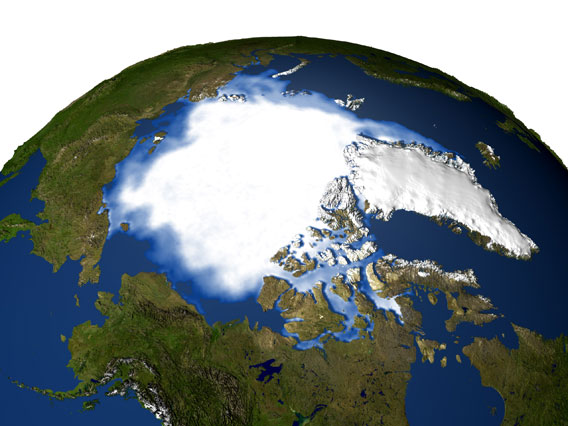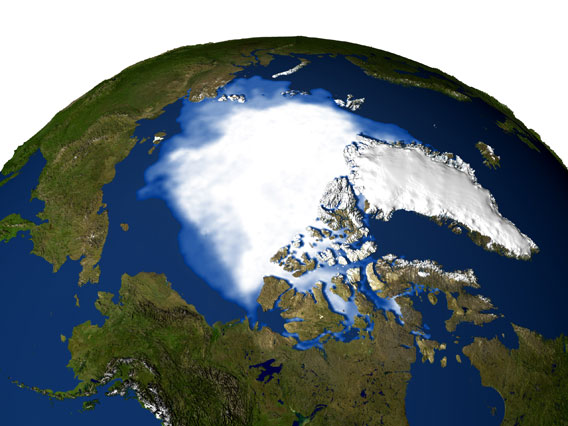NASA satellites detect continuing decline in Arctic sea ice
NASA release
October 1, 2005
Researchers from NASA, the National Snow and Ice Data Center and others using satellite data have detected a significant loss in Arctic sea ice this year.
On Sept. 21, 2005, sea ice extent dropped to 2.05 million sq. miles, the lowest extent yet recorded in the satellite record. Incorporating the 2005 minimum using satellite data going back to 1978, with a projection for ice growth in the last few days of this September, brings the estimated decline in Arctic sea ice to 8.5 percent per decade over the 27 year satellite record.
Scientists involved in this research are from NASA’s Goddard Space Flight Center, Greenbelt, Md., NASA’s Jet Propulsion Laboratory, Pasadena, Calif., the National Snow and Ice Data Center at the University of Colorado, Boulder, and the University of Washington, Seattle.
Satellites have made continual observations of Arctic sea ice extent since 1978, recording a general decline throughout that period. Since 2002, satellite records have revealed early onsets of springtime melting in the areas north of Alaska and Siberia. In addition, the 2004-2005 winter season showed a smaller recovery of sea ice extent than any previous winter in the satellite record and the earliest onset of melt throughout the Arctic.

Sea Ice Minimum 1979-1981. Courtesy of NASA.

Sea Ice Minimum 2003-2005. Courtesy of NASA.
Arctic sea ice typically reaches its minimum in September, at the end of the summer melt season. The last four Septembers (2002-2005) have seen sea ice extents 20 percent below the mean September sea ice extent for 1979-2000.
Perennial ice cover is ice that survives the summer melt, consisting mainly of thick multiyear ice floes that are the mainstay of the Arctic sea ice cover. “Since 1979, by using passive microwave satellite data, we’ve seen that the area of Arctic perennial sea ice cover has been declining at 9.8 percent per decade,” said Joey Comiso, senior scientist at Goddard.
RELATED ARTICLES Rising carbon dioxide levels could devastate marine food chain – 29-September-2005 Decline of Arctic sea ice increases – 29-September-2005 Is there a link between the Arctic and hurricanes? – 29-September-2005 Capturing and storing the carbon dioxide could be key in minimizing climate change – 26-September-2005 Summers in arctic getting longer and hotter – 23-September-2005 Hurricane Katrina damage just a dose of what’s to come 21-September-2005 90% of largest companies concerned about climate change — survey 18-September-2005 Humans impacted climate thousands of years ago September 9, 2005 Carbon reinjection strategies to be affected by climate change September 8, 2005 Ocean gas hydrates could trigger catastrophic climate change September 6, 2005 Global warming may have triggered worst mass extinction August 29, 2005 |
For the perennial ice to recover, sustained cooling is needed, especially during the summer period. This has not been the case over the past 20 years, as the satellite data show a warming trend in the Arctic, and it is not expected to be the case in the future, as climate models project continued Arctic warming. If ice were to grow back in these areas, the new ice would likely be thinner and more susceptible to future melt than the thick perennial ice that it replaces.
Scientists are working to understand the extent to which these decreases in sea ice are due to naturally occurring climate variability or longer-term human influenced climate changes.
Scientists believe that the Arctic Oscillation, a major atmospheric circulation pattern that can push sea ice out of the Arctic, may have contributed to the reduction of sea ice in the mid-1990s by making the sea ice more vulnerable to summertime melt.
Sea ice decline could also affect future temperatures in the region. Ice reflects much of the sun’s radiation back into space. As sea ice melts, more exposed ocean water reduces the amount of energy reflected away from the Earth. “Feedbacks in the system are starting to take hold,” says the National Snow and Ice Data Center’s lead scientist Ted Scambos.
Claire Parkinson, senior scientist at Goddard, cautions against thinking that Arctic sea ice is gone for good, especially with such limited data. “The reduced sea ice coverage will lead to more wintertime heat loss from the ocean to the atmosphere and perhaps therefore to colder water temperatures and further ice growth,” said Parkinson.
There are many factors beyond warmer temperatures that drive changes in the Arctic. A longer data record, combined with observations from additional environmental parameters now available from NASA satellites, will help scientists better understand the changes they are now seeing.
The study used data from the Defense Meteorological Satellite Program Special Sensor/ Microwave Imager and data from NASA’s Scanning Multi-channel Microwave Radiometer (SMMR) on the NIMBUS-7 satellite.
This is an adapted press release from NASA. The original version appears at Satellites Continue To See Decline In Arctic Sea Ice In 2005